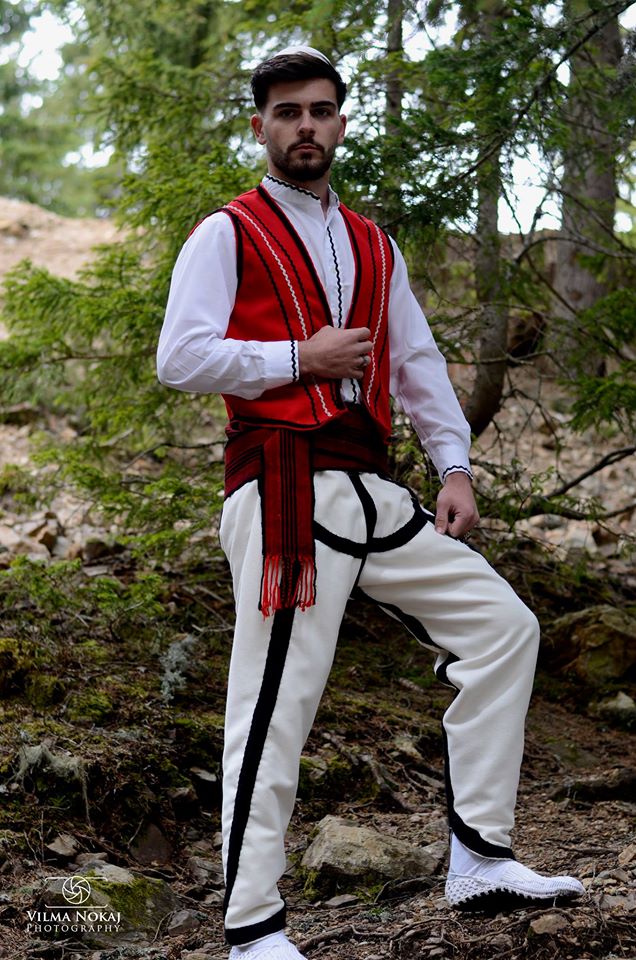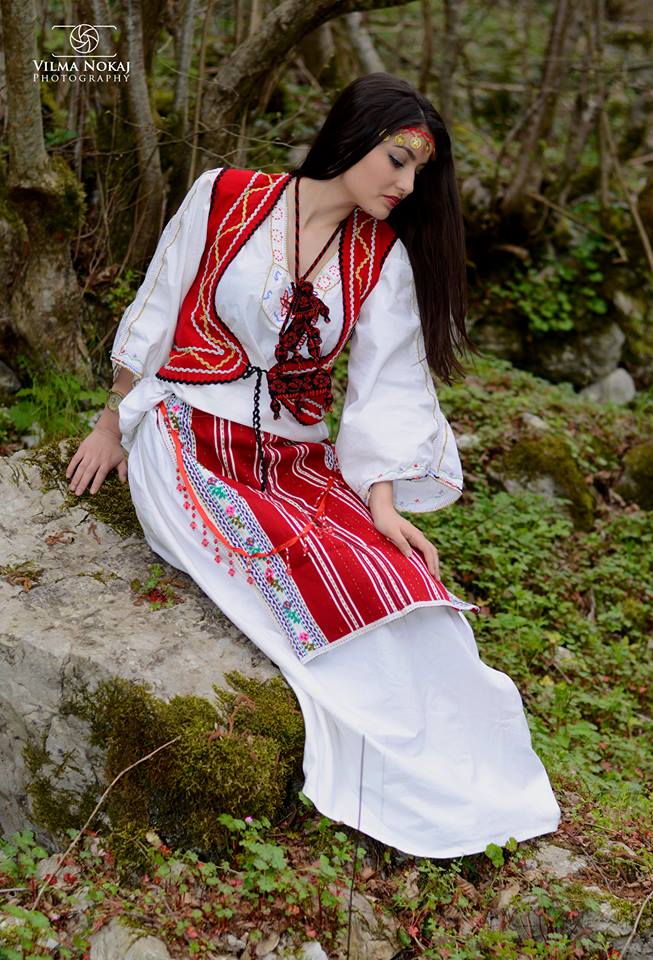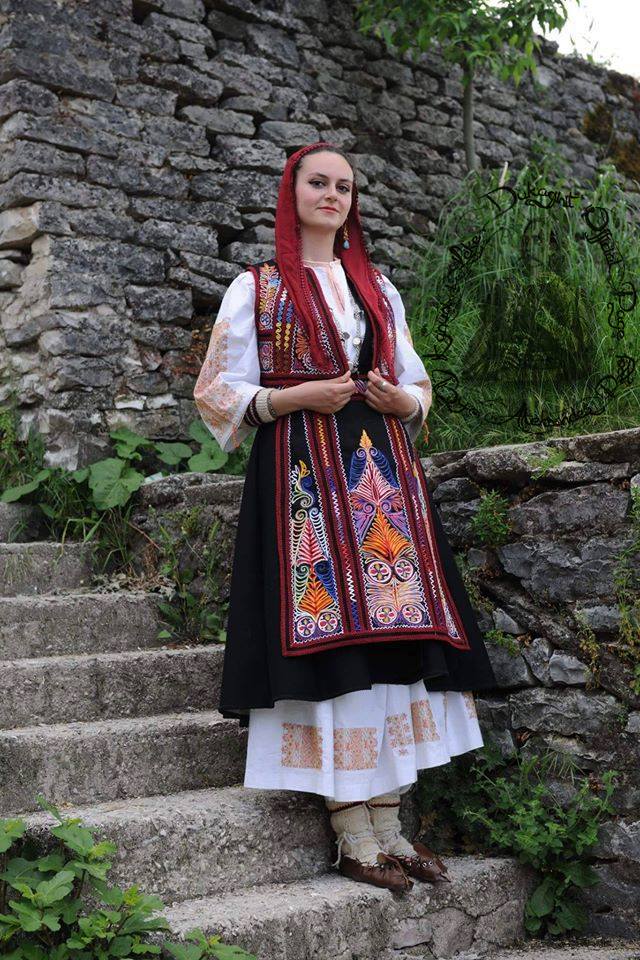
Veshje popullore 🇦🇱🇦🇱🇽🇰 Rekes Gostivar Albanian clothing, Folk clothing, Traditional outfits
Qeleshe [cɛˈlɛʃɛ] or plis: a type of hat worn by men in Albania, Kosovo, and the Albanian-speaking parts of Greece and North Macedonia. In central Albania ( Tirana, Durrës, Kavaja) it is cone-shaped, and in North Albania and Kosovo round. Albanian hat ( French: Chapeau albanois) worn typically during the 15th to 18th centuries

Albanian traditional costume Albanian culture, Traditional outfits, Albanians
April 26, 2023 by Lost traveller Welcome to our guide on Albania's traditional dress and customs! In this article, we will take you on a journey through the history and significance of Albanian traditional dress, exploring the different types of traditional garments worn by men, women, and children.

Traditional Albanian clothing from Miridta Albanian culture, Costumes around the world
Nowadays Albanians are westernized and many dressing options are available. Young people, but also adults, wear jeans, miniskirts, etc, similar with people from western world. However, traditional clothing still exists among Albanian people. Traditional clothing is made by specialized craftsmen and women with cotton, wool and silk.

Traditional Albanian Costumes Traditional Clothing of Albanians Photo (39619581) Fanpop
Albania National symbols. ⏪ Back to the national symbols of Albania. What is Albania known for? Albania is known for its vibrant buildings and street art in Tirana, its exotic beaches, castles from the Middle Ages, and Ottoman-era architecture

Traditional Albanian Costumes Traditional Clothing of Albanians Photo (39619598) Fanpop
RM 2G3619P - people, men, man in Albanian traditional costume, full length, 2nd half 19th century, clothes, ADDITIONAL-RIGHTS-CLEARANCE-INFO-NOT-AVAILABLE. RM 2M99NXJ - Albanian peasants in colourful national costume, woman and child. RM E60YWT - Albanian lady in national costume, 19th century.

Traditional Albanian costume from Lunxhëria, Gjirokastra (southern Albania) Folk Dresses, Modest
Albanian men also wore various silver ornaments, such as breastplates, decorative badges on vests, rings, pipes and cigarette boxes, but above all, belt and arm weapons, which were always richly decorated. For women, the main clothing was the " xhubleta ". It is a traditional folk costume of women, characterized by a bell-shaped bottom.

Traditional Albanian Costumes Traditional Clothing of Albanians Photo (39619580) Fanpop
Albanian culture or the culture of Albanians ( Albanian: kultura shqiptare [kultuˈɾa ʃcipˈtaɾɛ]) is a term that embodies the artistic, culinary, literary, musical, political and social elements that are representative of Albanians.

Image result for traditional albanian dress Albanian clothing, Albanian culture, Folk clothing
Albanian dress consists of the following Headgear Men The following headdresses are in use for men: Qeleshe [cɛˈlɛʃɛ] or plis: a type of hat worn by men in Albania, Kosovo, and the Albanian-speaking parts of Greece and North Macedonia. In central Albania ( Tirana, Durrës, Kavaja) it is cone-shaped, and in North Albania and Kosovo round.

Traditional clothing from central Albania Wedding Outfit, Wedding Gowns, Albanian Culture
Traditional Jewellery and Dress from the Balkans Explore the British Museum's collection of spectacular jewellery and costume from the Balkans British Museum The area known as the Balkans is.

Traditional Albanian Costumes Traditional Clothing of Albanians Photo (39619574) Fanpop
The traditional Albanian clothing (Albanian: Veshjet Tradicionale Shqiptare; Veshjet Kombëtare; Veshjet Popullore or Kostumet Kombëtare) includes more than 200 different varieties of clothing in all Albania and the Albanian-speaking territories and communities (including the Arbëreshë in Italy, Arvanites in Greece and Arbanasi in Croatia).

Why does the Albanian national dress look identical to the Greek one? Quora Russian clothing
The Albanian Ali Pasha of Tebelen (1740-1822) (fig. 1), son of a local leader, ruled from 1788 to 1822 as governor of the Ottoman province of Roumelia, territories corresponding to southern Albania as well as northern and central Greece, at Ioannina, capital of Epiros.

Traditional Albanian Costumes Traditional Clothing of Albanians Photo (39619569) Fanpop
Albanians are modest, however. Neither men nor women of Albania wear shorts or other revealing clothing. Traditional clothing is seen mostly at theatrical or folk dance performances in Albanian cities. Albanian Traditional Costumes are the traditional clothing worn by the Albanians.

Albanian bridal dress traditionalcouturetina Robe soirée mariage, Robe de bal, Robe
Albanian national dress consists of traditional skirts and square-shaped headdresses for women, while Albanian hats and long pants worn by men were influenced by Ottoman Empire. Albania's traditional costumes, such as conventional socks and high woolen hat, is a way the upper body covers.

Albanian traditional dress from Upper Reka, Macedonia. Folk Costume, Costumes, Albanian Culture
Both Greece and Albania claim the fustanella as a national costume. [7] Origins A terracotta figurine with a fustanella garment (i.e. a pleated skirt wore by a man) was found in Durrës, in present-day central Albania, dating back to the 4th century CE, clearly providing an early archaeological evidence of a fustanella. [8]

Ndihmo, Zot, si m'ke ndihmue! — ArbëreshAlbanian woman from Caraffa di Catanzaro,... Albanian
The most famous Albanian traditional clothing for men is the fustanella, a skirt-like item. For women, it is the xhubleta which is a bell-shaped skirt. There are many similarities between traditional Albanian costumes and traditional clothing from other Balkan regions.

Albanian clothing, European outfit, Traditional outfits
The most famous Albanian traditional clothing for men is the fustanella, a skirt-like item. For women, it is the xhubleta which is a bell-shaped skirt. There are many similarities between traditional Albanian costumes and traditional clothing from other Balkan regions.